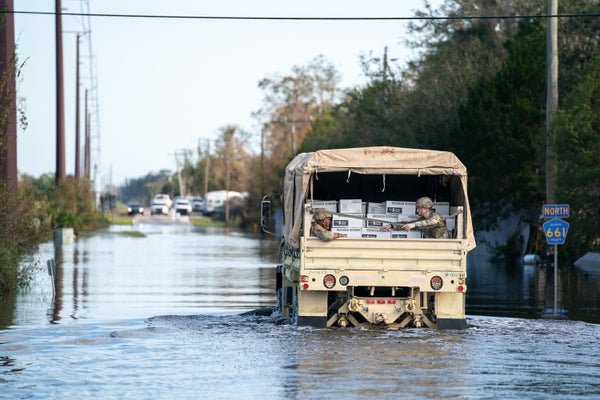CLIMATEWIRE | U.S. troops have long provided assistance to disaster victims. But there's little public information about when, where and how those deployments occur.
The nonpartisan Center for Climate and Security will try to fill that void with a new web-based data tool that allows internet users to track military deployments — nationally and internationally — in response to hurricanes, floods, wildfires, heat waves and other climate-related disasters.
The Military Responses to Climate Hazards (MiRCH) tracker will be a repository for such information, according to its creators, and could shed light on how the military’s traditional war-fighting mission is evolving under a warming climate. The site will provide updates on U.S. deployments and those of other nations.
On supporting science journalism
If you're enjoying this article, consider supporting our award-winning journalism by subscribing. By purchasing a subscription you are helping to ensure the future of impactful stories about the discoveries and ideas shaping our world today.
“It’s important to the conversations we’re having about climate change and national security to really understand what it means for militaries to have to respond to disasters, not only here in the U.S., but looking at our allies, partners and even adversaries around the world,” Erin Sikorsky, the center’s director, said in an interview.
The idea of a military disaster-response tracker came from an informal Twitter conversation by experts monitoring disaster deployments around the world.
“We wanted a more formal tracking mechanism so we could compare [deployments] over time. We wanted to do better data collection and present the data visually,” Sikorsky said in a phone interview. The tracker includes deployments of all military troops, including from countries directly affected by disasters and assisting troops from other places.
Though still in its infancy, the tool already has identified 84 global disasters that have warranted some form of military response since June 2022, including 18 events in the United States.
For example, U.S. troops were deployed in response to unprecedented flooding caused by an April rain bomb in Fort Lauderdale, Fla., and to help evacuate thousands of Californians from a 20,000-acre wildfire that roared through Mariposa County last July. In North Dakota, National Guard deployments happen nearly every spring to help sandbag communities along the Red River where warming springs result in faster snowmelt and runoff.
According to the National Guard, many of its 450,000 members “were involved in lifesaving natural disaster responses in 2022,” including 142,000 deployments to fight wildfires and another 18,000 to aid state and local officials during flood disasters. An additional 12,000 National Guard deployments were in response to winter storms, according to the service.
Joe Bryan, the Defense Department's chief sustainability officer and senior adviser to Defense Secretary Lloyd Austin, told an online seminar hosted by the Brookings Institution last year that “climate change is driving demand for mission — from humanitarian assistance and disaster relief to changes in the Arctic."
And he said "it is also impacting the military’s readiness and ability to respond to these crises; for example, the military must evacuate when wildfires hit an installation. The DOD must invest in resources to reduce these risks which are becoming increasingly commonplace.”
Sikorsky said she wouldn’t characterize the Defense Department's increasing role in climate disasters as “undermining readiness overall."
But, she added, "when they look at the trajectory of where we’re going with climate change, especially over the next several decades, they are concerned.”
The open-access tool can be updated by government officials, researchers, journalists and others who track military responses to climate disasters around the world. The center will ensure the information is accurate and up to date, she said.
Reprinted from E&E News with permission from POLITICO, LLC. Copyright 2023. E&E News provides essential news for energy and environment professionals.
